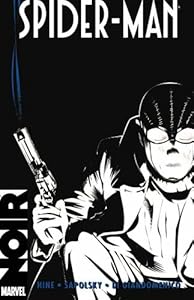Scarlet Spider Volume
2: Lone Star
 |
| Featuring explosions, big hats, and anger |
Writer: Christopher Yost
Artists: Khoi Pham, Paulo Siqueira and Niel Edwards
Owned as trade paperback.
Background info:
Scarlet Spider (or just Kain) is an anti-hero. Having failed at fleeing to Mexico, he now serves as Houston's Spiderman. He takes care of Aracely, an immigrant who has some kind of mystic power. That's really all you need to know.
Review:
Volume 1 of Scarlet
Spider was enjoyable, but at the end of the day, it was mostly character
development. Writer Christoper Yost hinted at more happening, but the first
volume did little more than establish who exactly Kain Parker was.
Now, it seems, Yost can finally get into the good stuff.
Lone Star really
follows two major stories. Both of which differ in mood and theme. The first
story is light-hearted and genuinely funny. After saving the daughter of a
corrupt CEO, Kain starts digging deeper into the actions of a company known a
Roxxon; an oil drilling firm that cover their dodgy actions with the fact that
they seem to employ half of Houston. This brings the attention of a group known
as the Rangers. The Rangers, simply put, are redneck avengers. Sorry to the
once independent nation of Texas, but when your team’s leader is called “Texas
Twister”, it’s hard to take you seriously.
This is the side of Kain that Life After Death got us used to. A perpetually grumpy Parker clone
has a personal grudge against everyone. He’s the kinda guy for whom handling a
situation delicately means throwing a girl out of a skyscraper window. It’s
laugh-out-loud funny to see this guy get continually frustrated at the notion
of becoming a hero. Couple that with the psychic Aracely and her
innocent-yet-odd comments, it becomes a great example of what Marvel are best
at; light-hearted takes on superheroics that thoroughly entertain.
The second major story changes that tone completely, and
that may be a by-product of skipping over a few issues so they can be included
in the Minimum Carnage trade.
Aracely, a girl who relies on Kain for protection is being chased by, wait for
it... werewolves.
Talking werewolves.
Talking werewolves from Mexico.
Although it doesn’t exactly scream dark, it’s amazing how
dark this story ends up being. I’ve said before that Scarlet Spider is a Batman
fan’s Spiderman. This story makes him so much more. There’s elements of the
Hulk, Doctor Fate, and even genuine horror. This brings out the dark story that
I was personally waiting for in Scarlet
Spider. Even Kain’s inner dialogue changes theme in this one, whereas the first
story is all about cursing everyone who ever made him a hero, this second story
is all about Kain walking the fine line between hero and monster, and it’s a
great read.
The tone shifts in both stories are accompanied by
appropriate artwork. The first story looks much like the previous volume- it’s
bright, it’s colourful, and it makes the funny scenes even funnier. The second
story uses a darker tone and that, naturally, accentuates the psychological
depth of Kain that Yost has been working so hard to establish.
The duality is entertaining, but it’s also the book’s
inherent flaw. Although I recognised Kain the whole way through, reading two
different tones forced me to reacquaint myself with the character halfway
through the book. If you’re listening, Marvel, this is not a good thing. The
Kain in the second story was totally different to that of the first. It’s
disappointing, especially since I don’t know which Kain I prefer. Reading this
trade therefore left me feeling conflicted about what I could expect from
Volume 3.
All the same, though, Lone
Star is a great book that takes advantage of some careful character
planning and gets a four and a half out of five Mexican werewolves.
**** ½
+ Two great stories
+ Artwork matches
- Stories don’t really mesh that well together.
Alternate option: Scarlet Spider: Life After Death
As close to Kain's origin story as you're gonna get.






